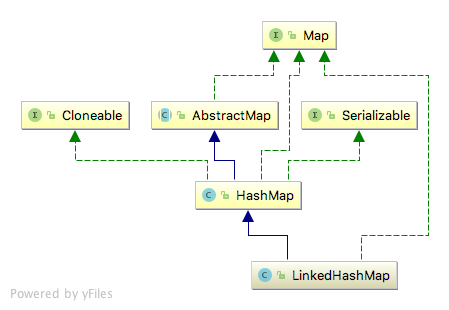如果你对 HashMap 的源码有了解的话,只需要一图就能知道 LinkedHashMap 的原理了,但是具体的实现细节还是需要去读一下源码。

一、LinkedHashMap 简介
1.1 继承结构
从继承结构上来讲 LinkedHashMap 继承自 HashMap,LinkedHashMap 中没有提供任何增删改查的方法,而是直接复用了父类 HashMap 中的方法。

1.2 内部数据结构
LinkedHashMap 继承自 HashMap,HashMap 底层存储键值对的数据结构是 Node 和 TreeNode,而 LinkedHashMap 存储键值对的数据结构是 Entry 和 TreeNode。
// Entry 继承自 HashMap 中的 Node 类,用于链表存储键值对
static class Entry<K,V> extends HashMap.Node<K,V> {
// 前置与后置节点,用于维护 LinkedHashMap 的键值对顺序
Entry<K,V> before, after;
Entry(int hash, K key, V value, Node<K,V> next) {
super(hash, key, value, next);
}
}
Entry 用于存储链表中的键值对,用 before 与 next 指针维护插入键值对的顺序,那树节点是怎么维护插入顺序的呢?在 LinkedHashMap 中是没有 TreeNode 类的,因为它复用了 HashMap 中的 TreeNode,下面我们来看一下 HashMap 中 TreeNode 的定义。
我们只看这一行代码就行了,你会发现 HashMap 中 TreeNode 类继承了 LinkedHashMap 的 Entry,这样一来就继承了父类的前置与后置指针,也就能维护 LinkedHashMap 的插入顺序了。
static final class TreeNode<K,V> extends LinkedHashMap.Entry<K,V>
1.3 构造函数
我们只看其中一个构造函数
public LinkedHashMap(int initialCapacity,
float loadFactor,
boolean accessOrder) {
// 调用 HashMap 的构造函数
super(initialCapacity, loadFactor);
this.accessOrder = accessOrder;
}
LinkedHashMap 只有这一个构造函数可以初始化 accessOrder,这个 accessOrder 属性又有什么作用呢,下面来解释一下,看了解释大家可能还会有点迷惑,后面结合代码大家就能理解这个字段的作用了。
/*
* 键值对迭代顺序策略
* true:access-order 访问顺序,使用迭代器遍历时,get 的元素会被添加到最后
* false:insertion-order 插入顺序
*/
final boolean accessOrder;
上面讲了那么多都是为相关源码分析作准备,下面我们就一起来看看吧。
二、添加键值对
上面我们也说了 LinkedHashMap 中没有 put 方法,因为都是复用的 HashMap 的,如果你想具体了解 put 方法,可以查看 HashMap 扩容机制与线程安全分析 这篇文章。
想要把键值对放到 LinkedHashMap 中去,一定会先封装成 Entry 或 TreeNode 节点,知道这个原理我们直接来看 newNode(以链表节点为例) 方法。
Node<K,V> newNode(int hash, K key, V value, Node<K,V> e) {
// 初始化 LinkedHashMap 键值对 Entry
LinkedHashMap.Entry<K,V> p =
new LinkedHashMap.Entry<K,V>(hash, key, value, e);
// 添加的键值对都会被添加到 LinkedHashMap 尾部,因此可以形成一个双向链表
linkNodeLast(p);
return p;
}
在 newNode 方法初始化 Entry 节点时调用了一个 linkNodeLast 方法,我想看到这里大家应该这道其中的原理了。
private void linkNodeLast(LinkedHashMap.Entry<K,V> p) {
// 获取并记录 tail 节点
LinkedHashMap.Entry<K,V> last = tail;
// 重置 tail
tail = p;
if (last == null)
head = p;
else {
// 将节点连接起来,构成双向链表
p.before = last;
last.after = p;
}
}
三、获取键值对
LinkedHashMap 的 get 方法调用了 HashMap 的 getNode 方法,获取到对应的节点后,返回对应的 value。
public V get(Object key) {
Node<K,V> e;
// 调用 hashMap 中的 getNode() 方法,根据 key 的哈希值找到对应的桶位置,判断节点后(链表、头结点、树节点)进行返回
if ((e = getNode(hash(key), key)) == null)
return null;
// 如果 accessOrder 为 true,获取元素后把当前键值对调整到尾部
if (accessOrder)
afterNodeAccess(e);
return e.value;
}
下面我们来看一下 getNode 方法都做了什么。这个方法做的事情很简答, 根据 key 计算出对应的哈希值,根据哈希值计算出对应的桶位置,然后遍历节点进行查找。
final Node<K,V> getNode(int hash, Object key) {
Node<K,V>[] tab; Node<K,V> first, e; int n; K k;
// 进行判断并通过 tab[(n - 1) & hash] 计算当前 key 在哈希表中的位置
if ((tab = table) != null && (n = tab.length) > 0 &&
(first = tab[(n - 1) & hash]) != null) {
// 如果是当前桶位置上的头节点直接返回
if (first.hash == hash && // always check first node
((k = first.key) == key || (key != null && key.equals(k))))
return first;
// 如果头节点不是要找的节点,判断是树节点还是链表节点后继续查找
if ((e = first.next) != null) {
if (first instanceof TreeNode)
return ((TreeNode<K,V>)first).getTreeNode(hash, key);
// 链表、从头节点开始遍历查找
do {
if (e.hash == hash &&
((k = e.key) == key || (key != null && key.equals(k))))
return e;
} while ((e = e.next) != null);
}
}
return null;
}
上面的 get 方法中还有一个需要注意的地方,如果 accessOrdera 为 true 则调用 fterNodeAccess(e); 方法,这个方法又是干嘛用的呢,在最开始的时候我们说过,LinkedHashMap 支持两种迭代策略,分别是访问顺序(默认)与插入顺序,这个 fterNodeAccess(e); 方法就是用于支持访问顺序的。
如果 accessOrdera 为 true,那么在调用 get 方法时会将该键值对置为双向链表的尾节点。
void afterNodeAccess(Node<K,V> e) { // move node to last
LinkedHashMap.Entry<K,V> last;
// 判断迭代策略,并且当前节点不是尾节点
if (accessOrder && (last = tail) != e) {
// 记录当前节点,并获取前后节点
LinkedHashMap.Entry<K,V> p =
(LinkedHashMap.Entry<K,V>)e, b = p.before, a = p.after;
// 把当前节点的 after 节点置 null
p.after = null;
// 如果当前节点是头节点,把后一个节点置为头节点
if (b == null)
head = a;
// 把当前节点的前后节点相连
else
b.after = a;
if (a != null)
a.before = b;
else
last = b;
if (last == null)
head = p;
// 把当前节点置为尾节点并记录
else {
p.before = last;
last.after = p;
}
tail = p;
++modCount;
}
}
四、HashMap 与 LinkedHashMap 对比
除了双向链表外,HashMap 与 LinkedHashMap 还有什么区别吗?
4.1 containsValue 方法对比
HashMap 中代码如下,遍历哈希表中的所有桶,然后遍历桶位置上的所有节点。
public boolean containsValue(Object value) {
Node<K,V>[] tab; V v;
if ((tab = table) != null && size > 0) {
// 遍历哈希表
for (int i = 0; i < tab.length; ++i) {
// 遍历当前桶上的所有节点
for (Node<K,V> e = tab[i]; e != null; e = e.next) {
if ((v = e.value) == value ||
(value != null && value.equals(v)))
return true;
}
}
}
return false;
}
LinkedHashMap 中代码如下,从头节点遍历,一直遍历到尾节点。
public boolean containsValue(Object value) {
/**
* 遍历双向链表,判断 value,与 HashMap 完全不同
*/
for (LinkedHashMap.Entry<K,V> e = head; e != null; e = e.after) {
V v = e.value;
if (v == value || (value != null && value.equals(v)))
return true;
}
return false;
}
4.2 nextNode 方法对比
HashMap 中的 nextNode() 方法,遍历哈希表数组,接着遍历桶位置上的所有节点。
final Node<K,V> nextNode() {
// 记录哈希表数组
Node<K,V>[] t;
Node<K,V> e = next;
if (modCount != expectedModCount)
throw new ConcurrentModificationException();
if (e == null)
throw new NoSuchElementException();
// 过滤掉没有键值对的桶位置
if ((next = (current = e).next) == null && (t = table) != null) {
do {} while (index < t.length && (next = t[index++]) == null);
}
// 下一个有键值对的桶(单个节点、树节点或链表)
return e;
}
LinkedHashMap 中的 nextNode() 方法,根据双向链表的顺序迭代键值对。
final LinkedHashMap.Entry<K,V> nextNode() {
LinkedHashMap.Entry<K,V> e = next;
if (modCount != expectedModCount)
throw new ConcurrentModificationException();
if (e == null)
throw new NoSuchElementException();
current = e;
// next 为双向链表的下一个节点
next = e.after;
return e;
}
jdk1.8 源码阅读:https://github.com/zchen96/jdk1.8-source-code-read